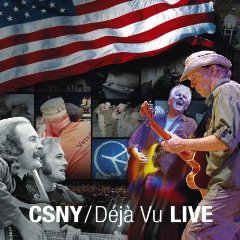Upon returning from catching Neil Young live in a Kentish field, a young Turk of my acquaintance, hot for info on his new-found hero, recently asked me “…who were the other three people in Crosby, Stills, Nash and Young?”
The question was delivered with no hint of irony whatsoever. After rolling my eyes skywards, I attempted to deliver potted histories of The Byrds, Buffalo Springfield, The Hollies and how these disparate artists discovered the magic of their unique harmonizing when Salfordian upstart Graham Nash muscled his way into a practice, reputedly at the house of Steven Stills (although reports vary). Along the way I mentioned Woodstock, of course and the manner in which CSN and Y became more mothership, than band; a place where their respective talents could settle, integrate, revamp.
The apparent democracy of peak-time CSN and Y seemed to astonish my friend as I sent him scuttling off in search of Déjà vu and the foursome’s last live recording, the sprawling Four Way Street, recorded when the gravitas was more or less evenly spread.
I suppose I shouldn’t have been so surprised by this. The dominance of Neil Young within the context of CSN and Y has never seemed so unbalanced. Confirmation of that fact arrives with CSNY/Deja Vu Live, recorded on the Freedom of Speech Tour in 2006 and the soundtrack to the subsequent film.
The title is immediately misleading and, at first glance, suggests that this will be a down-the-line run through of the band’s classic Déjà vu album and, given the current elevated status of all things Americana, this would surely be understandable. It was Neil Young, however, who preferred to use the power of a CSN and Y reunion to bolster his profound anti-Bush feelings (which are undoubtedly shared by the others) and the refreshing open protest of his Living With War album. As such, Deja Vu Live is effectively Living With War Live, the album supplemented by familiar contributions from Crosby (Deja Vu), Nash (Teach Your Children) and the Stills penned Buffalo Springfield classic, ‘For What It’s Worth’). Only the inclusion of the surging, still-captivating ‘Wooden Ships’ (credited to Crosby, Stills and Jefferson Airplane’s Paul Kantner) truly seems to capture the balance of a band of equals. That stated, Crosby and Nash do pitch in with themic titles such as the opening ‘What Are Their Names’ and Nash’s paranoiac ‘Military Madness’
There are, of course, two ways of looking at this. Misty eyed nostalgics, of which I am one, will undoubtedly feel a twinge of disappointment upon scanning a set list so heavily weighted towards Living With War. The paradox is that to move CSN and Y into the contemporary era, and particularly with such political intent, is surely closer to the spirit of the band who charmed the vast audience of Woodstock (live, in the cinema and on record) with such an astonishingly complex rendition of ‘Suite; Judy Blue Eyes’. Returning to ‘Four Way Street’ may be a better way of rediscovering that magic. In addition – and young bands take note – these are four musicians who have always shown a commendable tendency to air their views, see the dark sweetness of Young’s ‘Ohio’ as a perfect example.
Also, of course, a softened fattened-out, lumped ‘greatest hits’ tour would ultimately only serve to weaken the legacy.
As such, we should welcome the immediacy of Living With War, which was never a bad album. Proof of that lies in the songs here, augmented by the still-nerve tingling vocal contributions of the others and, in parts, a 100 string choir. The opening and aforementioned ‘What Are Their Names?’ immediately encouraging audience participation with scant instrumentation before fading into the disarming, lilting beauty of the ‘Living With War -Theme’, which is later reprised to haunting effect.
While no bad songs clutter Living With War, they do occasionally display a clunky-feel not at all associated with Young’s finer work, even on latterday albums. This is largely due, one suspects, due to Young’s desire to punch his strength of feeling across. You wouldn’t really expect a song called ‘Shock and Awe’ to drift sweetly around the treetops, would you?
What isn’t so apparent on this soundtrack, but evidently surfaces on the film, is the curious notion of a divided audience. Not all long-term CSN and Young devotees, it seems, are so forthcoming in their anti-war allegiances. That stated, and it may be my imagination, but there does seem to be a slight hesitation – a tension even – between the songs. Perhaps no bad thing. Blind adoration, as we have seen many times, can be a dangerously naive beast. Nevertheless, there will be no disturbing Dixie Chicks style backlash in this instance.
But the ultimate test here remains in that schizophrenic balance of new and old and it’s almost a relief to note that the endearing freshness on this album is largely to be found within the older songs. As such, ‘Wooden Ships’, ‘Teach Your Children’ and ‘For What It’s Worth’ remains unchallenged, and gloriously so. Bearing that in mind, this is an album that superbly complements the legacy. It does not work, however, as an introduction to four extraordinary talents.


